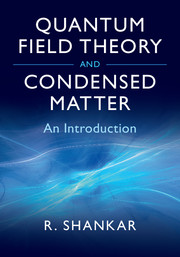Book contents
- Frontmatter
- Dedication
- Contents
- Preface
- 1 Thermodynamics and Statistical Mechanics Review
- 2 The Ising Model in d = 0 and d = 1
- 3 Statistical to Quantum Mechanics
- 4 Quantum to Statistical Mechanics
- 5 The Feynman Path Integral
- 6 Coherent State Path Integrals for Spins, Bosons, and Fermions
- 7 The Two-Dimensional Ising Model
- 8 Exact Solution of the Two–Dimensional Ising Model
- 9 Majorana Fermions
- 10 Gauge Theories
- 11 The Renormalization Group
- 12 Critical Phenomena: The Puzzle and Resolution
- 13 Renormalization Group for the ϕ4 Model
- 14 Two Views of Renormalization
- 15 Renormalization Group for Non-Relativistic Fermions: I
- 16 Renormalization Group for Non-Relativistic Fermions: II
- 17 Bosonization I: The Fermion–Boson Dictionary
- 18 Bosonization II: Selected Applications
- 19 Duality and Triality
- 20 Techniques for the Quantum Hall Effect
- Index
- References
1 - Thermodynamics and Statistical Mechanics Review
Published online by Cambridge University Press: 24 October 2017
- Frontmatter
- Dedication
- Contents
- Preface
- 1 Thermodynamics and Statistical Mechanics Review
- 2 The Ising Model in d = 0 and d = 1
- 3 Statistical to Quantum Mechanics
- 4 Quantum to Statistical Mechanics
- 5 The Feynman Path Integral
- 6 Coherent State Path Integrals for Spins, Bosons, and Fermions
- 7 The Two-Dimensional Ising Model
- 8 Exact Solution of the Two–Dimensional Ising Model
- 9 Majorana Fermions
- 10 Gauge Theories
- 11 The Renormalization Group
- 12 Critical Phenomena: The Puzzle and Resolution
- 13 Renormalization Group for the ϕ4 Model
- 14 Two Views of Renormalization
- 15 Renormalization Group for Non-Relativistic Fermions: I
- 16 Renormalization Group for Non-Relativistic Fermions: II
- 17 Bosonization I: The Fermion–Boson Dictionary
- 18 Bosonization II: Selected Applications
- 19 Duality and Triality
- 20 Techniques for the Quantum Hall Effect
- Index
- References
Summary
This is a book about techniques, and the first few chapters are about the techniques you have to learn before you can learn the real techniques.
Your mastery of these crucial chapters will be presumed in subsequent ones. So go though them carefully, paying special attention to exercises whose answers are numbered equations.
I begin with a review of basic ideas from thermodynamics and statistical mechanics. Some books are suggested at the end of the chapter [1–4].
In the beginning there was thermodynamics. It was developed before it was known that matter was made of atoms. It is notorious for its multiple but equivalent formalisms and its orgy of partial derivatives. I will try to provide one way to navigate this mess that will suffice for this book.
Energy and Entropy in Thermodynamics
I will illustrate the basic ideas by taking as an example a cylinder of gas, with a piston on top. The piston exerts some pressure P and encloses a volume V of gas. We say the system (gas) is in equilibrium when nothing changes at the macroscopic level. In equilibrium the gas may be represented by a point in the (P,V) plane.
The gas has an internal energy U. This was known even before knowing the gas was made of atoms. The main point about U is that it is a state variable: it has a unique value associated with every state, i.e., every point (P,V). It returns to that value if the gas is taken on a closed loop in the (P,V) plane.
There are two ways to change U. One is to move the piston and do some mechanical work, in which case
dU = –PdV
by the law of conservation of energy. The other is to put the gas on a hot or cold plate. In this case some heat δQ can be added and we write
dU = δQ
which acknowledges the fact that heat is a form of energy as well. The first law of thermodynamics simply expresses energy conservation:
dU = δQ–PdV.
I use δQ and not dQ since Q is not a state variable.
- Type
- Chapter
- Information
- Quantum Field Theory and Condensed MatterAn Introduction, pp. 1 - 19Publisher: Cambridge University PressPrint publication year: 2017



